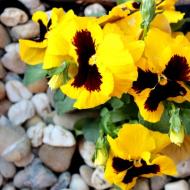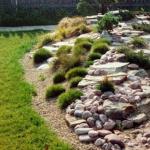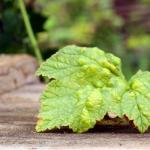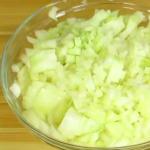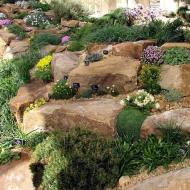
Alpine slide - how to make a rock garden with your own hands
If there is a ledge or unevenness in your dacha, plot or garden, make an alpine hill.
Firstly, such a flower bed is very beautiful, in a year its stony cliffs will cover with a solid carpet lovely cushions of flowers, herbs and mosses.
Secondly, the construction of the rock garden itself is a fascinating activity. Here you need to think everything over: where to plant coniferous shrubs, what stones and perennials to choose, so that a colored carpet in the middle of the rocky scree plays with colors for a whole year.
And thirdly, if the soil in your dacha is poor, sandy or rocky, and is completely unsuitable for organizing other types of flower beds, then the plants of the alpine hill in such conditions, on the contrary, will develop normally and bloom well.
Not everyone understands correctly what an alpine slide is. Structures made of plants and stones on the site are far from alpine slides.
Rock garden (alpine slide)- these are landscape compositions that imitate a mountain landscape with platforms like terraces with stones, squat shrubs and long-flowering perennials.
Consider some of the subtleties of designing an alpine hill flower bed
Rock garden in the garden, if possible, should be:
- isolated from outbuildings, playground, etc.;
- proportional to the entire area of the site;
- removed from flower beds with bright lush flowering;
- located in the most illuminated place of the site, close to the source of water supply (if this is not possible, then it will be necessary to equip additional irrigation points);
- as plausible as possible to the mountain landscape;
- located near the house or recreation area.
Many people thought about how to make an alpine slide with their own hands. And only a few, especially stubborn and patient, decorated their summer cottage with terraced hills. Where did they start? Of course, with the choice of location.
In order for a rocky flower bed to organically fit into the environment of the garden, it is not necessary to look for a large space - alpine plants are so compact that it costs nothing for them to fit dozens on a modest area of \u200b\u200bthe hill.
The height of the rock garden should not conflict with the already existing landscape. If possible, you need to make sure that the forms, textures and colors of the slide blend harmoniously into the concept of landscape design.
The alpine decorative flower garden in the garden looks very expressively against the background of dense, tall bushes or small but lush trees.
Do-it-yourself Alpine slide - step by step instructions
What materials and tools do you need to buy for an alpine slide?
- stones of the same breed, river sand, crushed stone, gravel, turf, humus, peat, limestone, earth and planting material;
- tape measure, cord, pegs, bayonet shovel, scrap metal, garden shovel with a long handle, wheelbarrow, scissors, ladle (in order to rake the earth out of the wide slide sump), garden watering can.
Is everything at hand? Then get to work!
- Any alpine slide project begins with a breakdown of the site and drawing the outline of the future flower garden (this is where you need a tape measure, pegs and a cord). The area under the flower garden is cleared, the soil layer is removed to a depth of 30-40 cm, weeded thoroughly and weeds are removed.
- When clearing is completely finished on a deepened area, it is necessary to make a gravel cushion - fill in a layer of gravel, slag and construction waste (broken brick, limestone or granite rubble is suitable), 10 cm thick. This kind of drainage will protect the roots of plants from waterlogging, preventing stagnation of groundwater, and provide adequate aeration.
- The water-permeable layer should be made thicker where the soil is very dense, structureless, silty and poorly permeable to water. Wetlands are the first enemy of alpine plants - ascetics are used to growing on slopes in light, stony-sandy, acidic soils.
- On top of the drainage layer (the base of the rock garden), it is necessary to make a sand cushion - pour a layer of river sand (5 cm thick), tamp well and water.
- Next, mix in equal proportions soddy soil (it can be prepared in advance or bought at any nursery), perlite, sand, pine bark, wood chips, fine gravel, crushed peat, humus and sphagnum.
- Do not add too much fertilizer to this layer. The over-enrichment of the land can lead to the fact that the trees and flowers on the hill grow too large or, conversely, die altogether. It is recommended to feed only some tuberous and bulbous, and then as rarely and carefully as possible.
- The finished soil mixture is poured over the entire surface of the hill, while modeling the relief of the rock garden on the model of the natural landscape. The embankment of the earth does not need to be made uniform and neat. Both on a large and on a small alpine hill in the garden, it is necessary to manually form "cliffs" and "valleys", "tops" and "plateaus", paths and transitions.
- After the residual backfilling of the area with a ball of earth, you can start laying stones, “laying” “pillows” of river sand under them.

What shape should the stones be in rock gardens and how to arrange them correctly?
Consider what stones are needed for a small and large alpine slide, their names and laying methods.
To organize such an exotic flower garden, you need to choose only those stony rocks that will not transfer heavy metals and salts to the soil, and will not oxidize the soil.
Hewn over the years, water and wind, irregularly shaped rocks in the landscape of the garden will look much better than freshly mined ones. Stone screes should be similar in structure, and preferably exactly the same, but at the same time different in size.
An excellent choice for rock garden has always been and will be: natural granite, organic limestone or decorative sandstone. Suitable forest boulder, dolomite, travertine, gneiss or basalt. Another option: serpentinite, elbrus, jasper, serpentine, quartz, etc.
Stones do not need to be collected in the fields and meadows. You can buy good copies in the quarry. The weight of one stone can reach approximately 15-100 kg. That is, for a stone flower bed measuring 1.5 x 3 m, the developer will need about 1-1.5 tons of stones.
We go further. Laying should begin from the bottom (from the foot) up - gradually moving from larger specimens of stones to smaller ones. The first form the core of the alpine slide. For this purpose, the largest and most beautiful boulder is chosen and placed in a small recess. To prevent the stone from rocking, it can be strengthened with rubble.
Advice. It is not necessary to lay with equal distances and geometric harmony - in the natural environment, on mountain slopes, stones and blocks are located in a chaotic mess.
When laying, you need to gradually deepen not only the core of the composition, but also all the other stones. The resulting sinuses are lightly covered with an earthen mixture for rock garden and watered with a sprayed jet of water - plants will be planted in them a little later.
In the upper part, a conical boulder looks beautiful, symbolizing the top of the mountain, surrounded by flat stones.
In the process of placing stones, landscape designers are advised to move away from the composition and evaluate the result from different angles. An alpine slide, decorated with your own hands, is considered ready if it looks holistic and harmonious even without conifers, shrubs and flowers.
But that's not all. Huge weight boulders and stones should lie down for two or three weeks, "settle down", so to speak. And only when the earth settles and you can start arranging a flower garden on an alpine hill.

Plants for an alpine slide - the key to a spectacular design
Hardened by the harsh climatic conditions of the highlands: cold, low atmospheric pressure, strong winds and temperature fluctuations, flowers for the alpine hill show amazing endurance in the difficult climate of Russia.
In order for the rock garden created in the country to really look like an oasis of a mountain landscape, shrubs and plants must be selected according to the following criteria:
- unpretentiousness to climate and soil;
- short stature;
- moderate growth;
- non-aggressive breeding method;
- multi-year development cycle.
Low-growing and ground cover plants for an alpine slide
- Acena Bukhanana;
- young;
- Hairy beard;
- Mining grate;
- tenacious;
- Kostenets hairy;
- Fern;
- Stonecrop short-leaved;
- decorative cabbage;
- fat woman;
- Sagebrush;
- Geichera;
- Spurge;
- Stachys.
Advice. Ground cover plants with a powerful root system are placed on the slopes of an alpine hill to prevent its erosion.
Flowering plants for an alpine slide
- Barberry;
- Colchicum;
- Veronica;
- Carnation;
- Gentian;
- Gypsophila, wulfenia;
- Delphinium;
- Dryad;
- Gorse lancet;
- Poskharsky's bell;
- Primula Allioni;
- Saxifrage;
- Bloodroot;
- Burachok;
- Buttercup is cereal;
- Edelweiss;
- Kachem creeping;
- Oenothera Missouri;
- Iberian catchment;
- Thyme;
- Gargan bell;
- Phlox is undersized;
- Soapweed basil leaf;
- Yaskolka;
- Draba evergreen;
- Mertensia maritime;
- Fuopsis long columnar;
- Krylovychinnik round-leaved;
- Strawberry decorative;
- Rose Rhodiola;
- Chiastophyllum oppositeleaf;
- Himalayan geranium;
- Mountain cornflower;
- Hellebore;
- Liverwort;
- Anemone;
- Cat's paw;
- Rezuha;
- Violets and daisies.
Advice. Each of the flowering individuals in the rock garden composition plays a role, so the flowers should not obscure and interfere with each other. It is important to achieve a smooth change in the shades of the slide. This can be easily achieved by combining alpine plants in terms of flowering.
Long-flowering plants for an alpine slide
Onion and bulbous
- Decorative Karatav;
- Cornflower and island bow;
- Tubergen's bow and Besianum;
- Scylla;
- Vesennik;
- Sternbergia;
- Cyclamen;
- Snowdrop;
- Ranunculus;
- Pushkinia;
- Clivia;
- Rhodohypoxis;
- Brandushka;
- Hyacites;
- lilies of the valley;
- Babian;
- Corydalis;
- Merender;
- Sisyrynchium;
- Thecophylea;
- Poultry farmers;
- Moricia;
- Muscari;
- garden ranunculus;
- Dwarf varieties of irises, daffodils, dahlias and tulips.
Advice. The rocky structures of the rock garden will look as decorative as possible if you know the exact timing of the flowering of the bulbous. And yet, when planting onions in a rock garden with good drainage (stones and gravel prevent the bulbs from rotting), leave enough space between them to grow. Mulch temporarily empty places with tree bark or pebbles.
Low-growing grasses for an alpine slide
- Quaking grass;
- Lagurus;
- Highlander;
- Cuff;
- Alyssum;
- Oregano;
- Reed grass spicy;
- Feather grass;
- Pennysetum orientalis;
- Fescue gray and red;
- Liriope;
- Sheep evergreen;
- Barley is maned;
- Esholz;
- Heathers;
- Erica.
Advice. Herbaceous plants remain attractive until late autumn, while others have already withered or have not yet blossomed. Acting as a background, ornamental grasses serve as a juicy decoration in the creation of an alpine slide.
Compact shrubs for alpine hills
- mountain pine;
- Boletus boletus;
- Blue spruce;
- Barberry;
- Cotoneaster horizontal;
- Juniper;
- Larch;
- Thuja western;
- Miniature Pine;
- Korean fir;
- Euonymus;
- Spirea;
- Dryad;
- Rhododendron;
- Daphne.
Advice. Plant dwarf trees and bushes first, highlighting the most spacious sections of the hill for them. Do not plant them on the sole or on top of the ground. The optimal place for upright dwarf forms in rock gardens is near large stones along the edges of the hill, at a great distance from each other. When properly planted, deciduous and coniferous shrubs will not require any special care from you. But some of them, for the winter period, you will have to cover by tying the plant with burlap or a special cover.
Very often, moss is included in the design of alpine slides. The transplantation of moss plates from the forest onto rock garden stones is carried out as follows. First, the moss pillow is cleaned from its native land, and then it is thoroughly mixed with a blender with a couple of tablespoons of sugar and 200 g of kefir. With the resulting homogeneous mass, you need to lubricate the sections of stones (using a brush), on which in the future they want to see a green carpet of moss. The plant will take root faster if it is regularly moistened within three weeks after planting.
A neatly trimmed green lawn can become a good frame for an alpine slide.
Advice. No need to try to place more species in the rock garden. You will succeed in a holistic composition only when, having learned about the types of plants from A to Z, you will be able to provide, albeit for a small number of flowers, a worthy existence.
Alpine hill - landing scheme
Between the stone scattering there should be enough space for the normal development and growth of green spaces. In a small hole dug at an angle, as shown in the figure, seedlings are planted, their roots are straightened, lightly sprinkled with earth and tamped. After planting, the hill needs to be watered. It is better to do this from top to bottom - the water, flowing down, will saturate the soil well and go straight to the roots.

When planting rosette flowers on a hill: orostachis, gentian, levisia, etc., do not plant them next to ground covers. The latter grow rapidly and can crowd out tender plants.
Plant bulbs will not spread if planted inside a limiter - a jar or an old bucket without a bottom.
Schemes of alpine slides (with the names of plants)
Scheme No. 1
![]()


Scheme No. 4

Types of Alpine slides
The paradoxical unity of fragile vegetation and boulders gives real pleasure to summer residents, disposes to reflection and soothes.
And after reading the article, you only have to choose: admire the bizarre harmony of the alpine slides in the photo or recreate one of the views on your site. Moreover, there are 7 of them at the stony flower beds at once:
- "rock" with natural fractures of the surface;
- rather difficult in execution "mountain slope" with coniferous and huge boulders;
- landscape "mountain valley" with asymmetrically placed groups of stones;
- "terraced slope" with retaining walls of various heights, lengths and shapes;
- decorative "forest ravine" with a spring or an artificially created waterfall;
- "stony wall" - a low mound with randomly scattered stones;
- the extravagant "Czech rolling pin", the defining technical feature of which is layered masonry;
- the most stylish of the stone compositions is the "alpine lawn" with wild plants growing exclusively in the highlands.
Conclusion
Do not listen to those who assure that a rock garden in a country house can be planned and created in one day. Of course not. Well, perhaps the simplest version of a mini alpine slide, and even then not in the garden, but in a city apartment.
Want to make things right? Then lay the drainage, fill the ground and form the base of the hill in the fall, and lay the stones and flowers and plant them only in the spring.
Alpine hill - photo of beautiful rock garden design options
![]()











